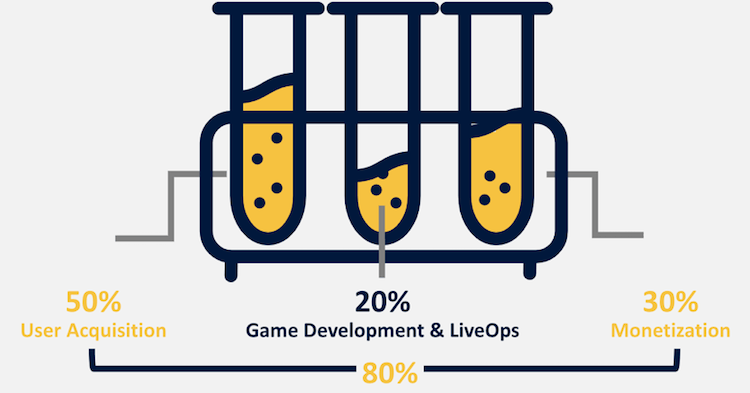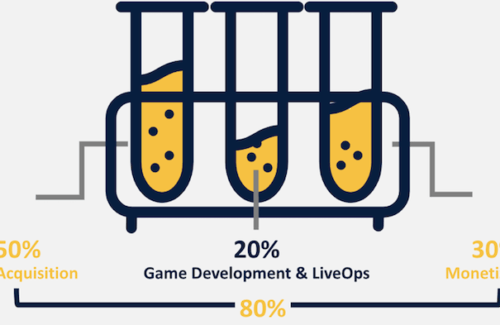
Today, we see that the mobile gaming market has fully matured, and the App Stores are dominated by mostly large and often public gaming companies like Supercell, Tencent, NetMarble, EA, Nintendo, Jam City, Sony, Rovio, King, and more.
In today’s market, it’s more challenging than ever to become a successfully competing small or mid-sized mobile gaming studio, but all hope is not lost. Profitable growth and top ranking in the app charts is possible with a game development approach that incorporates an integrated user acquisition (UA) and monetization strategy, and countless tenured gaming publishers and industry experts would agree.
There’s a trend happening specifically within hyper casual game development today that points towards the harmonization of UA and monetization and integration with development teams in which the gameplay is built around the ads like rewarded videos or the ad is built into the game in a clever way. This is a significant shift from the previous way of thinking, where these departments where working in silos. These days ads are becoming somehow an integral part of the user journey within the game. Recently Tal Shoham, COO of Developer Solutions at IronSource, made the prediction that for hyper-casual games, the teams that manage user acquisition and monetization will become increasingly in sync in order to have a stronger impact on performance.
Here we explore why and how this trend is happening today, and also how game developers can adopt and make the most of this approach to set their games up for a success.
The Hit-Driven Games Industry is Actually Becoming Predictable
The games industry has always been considered a cyclical or “hit-driven” industry, fueled by flagship titles and their sequels or unexpected breakout stars.
Over the years though, and with the maturity of the App Store, the games industry has turned data-driven and, as such, we’re seeing this hit-driven industry transform into the one with predictable successes. User-level data and real-time analytics on ad revenue have enabled game developers to identify who their highest quality users are and then target them through market channels (such as Facebook and Google), app campaigns and creatives designed to drive installs.
Regardless of studio size, taking a performance-based approach to game development is the key to success today, which means optimizing gameplay based on acquisition behaviors like player retention, monetization, lifetime value (LTV). Game studios are evolving from a narrow focus into broader, multi-disciplinary functions that incorporate facets of development with acquisition and marketing, and with monetization teams.
External Platforms Are Holding All the Cards and Getting Smarter
As the games industry has become more data-driven, game studios race to compete by relying on acquisition channels for growth. At the same time, Facebook and Google began building their “walled gardens” around their UA mechanics and user data, limiting the set of technology and data available to advertisers. Advertisers don’t know which of their user data is being pulled in to the algorithms to then target additional audiences, so this creates a “black box” effect. The purpose of a “walled garden” is such that Facebook and Google now have a duopoly on significant user data.
The advertiser acquires users, but learns nothing due to the black box, while these external platforms get smarter. As such, this is one of the biggest threats to game developers being able to integrate UA data, and key performance data, into their development strategy and roadmap.
Advertisers Are Getting Smarter About Targeting, Though
Data ownership is becoming increasingly critical. When a game developer supplies their targeting data to an advertising channel (like Facebook or Google), the developer gets smarter about targeting users as it measures the performance of its campaigns, and it can bring that new knowledge with it to any other platform.
It can also see how an acquired cohort of users performs in-game and using a more systematic and metric-driven approach, apply this intelligence into game development to increase game virality, retention and LTV.
- LTV: A developer may track how the initial onboarding process performs for a certain cohort and then make in-game adjustments based on the results. The first few minutes of a new player’s experience is critical – it must be enticing, simple, sticky, and engaging to ensure players stay for the long haul and generate revenue throughout their lifetime.
- Retention: Developers may look at which level a cohort of players is getting stuck and unable to progress (low completion rate), and thus the players leave the game and don’t return. They can then tune the gameplay mechanics based on this feedback.
The adverse of this is when targeting data is generated and kept by an advertising channel via algorithmic optimization, thus the developer learns nothing. This is what developers need to avoid in their advertising approach, and instead develop a process to collect and store proprietary UA data, so that they can use it for amplifying traffic and optimizing game performance.
Ultimately, a Hyper-Casual Game’s Success is Driven by UA and Monetization
In our experience and research, we’ve found that the two primary success factors of hyper-casual games and casual games are UA and monetization. And, this follows the 80:20 rule, where 20% is game development and liveops, while the 80% is a combination of UA (50%) and monetization (30%).
For this reason, hyper-casual and casual game developers need to turn UA and monetization into internal core competencies while growing from a small or mid-sized developer into a large games publisher. Otherwise, the developer will erode massive upsides for potential growth and run into significant risks, such as loss of user journey data (black box), squeezed margins (jeopardizing profitability) and loss of control (due to dependencies on external partners).
Conclusion
What does this mean for hyper-casual game developers? Partner up or start hiring and developing skill sets internally for UA and monetization, in addition to designing workflows that enable you to have more control over your acquisition data. It’s important to consider the link in the stages of game development with the stages of acquiring premium players for your game to become profitable.
Whether your goal is as straightforward as success in the competitive app stores, or growing your studio into a large-scale games publisher, this should be your primary focus for achieving that success.












